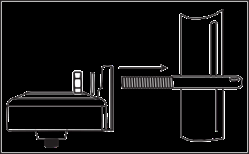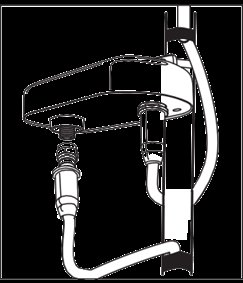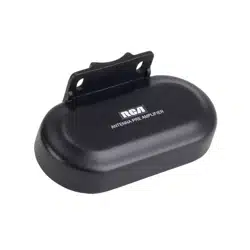Documents: Go to download!
User Manual
- User Manual - (English, Spanish)
- Warranty Card - (English)
- Troubleshooting - (English)
User manual Preamplifier
Preamplifier Installation
IMPORTANT: Do not plug in the power adapter until all connections are completed (step 8).
1. Set the FM TRAP switch on the bottom of the preamplifier.

The preamplifier’s FM Trap is set to ON by default. If you would like to turn it off, use a small flathead screwdriver to set this switch to OFF. (The switch is protected by a weatherproof cover that you’ll have to remove first.)
NOTE: For best perfomance, keep the FM trap in the ON position. If you use your antenna for FM as well as for TV broadcasts, switch the FM trap off. Please note, however, that switching the FM trap off may affect TV reception performance.
IMPORTANT: Make sure the weatherproof cover for this switch is back in place before you mount the preamplifier to your antenna mast.
2. Mount the preamplifier to your antenna mast.

Position the U-bolt on the antenna mast where you want to mount the preamplifier. Make sure you mount it within easy reach. Put the preamplifier on the U-bolt as shown. Then place the washers on both ends, followed by the nuts.
NOTE: For best results, mount the preamplifier as close to the antenna as possible.
3. Slide the weather boots over the antenna downlead.

Attach F-connectors to the coaxial cable if necessary.
4. Connect the antenna downlead to your antenna.
Leave enough slack in the cable to form a drain loop. You can secure the coaxial downlead to the mast with weatherproof tape or cable ties.
Slide the weather boot over the cable connector and boot collar on the antenna.
5. Connect the other end(s) of the antenna downlead(s) to the preamplifier.
Connect the downlead to the ANTENNA INPUT jack on the preamplifier.
Slide the weather boot over the cable connector and boot collar on the preamplifier.
6. Connect the preamplifier downlead to the preamplifier.

Connect the downlead to the OUTPUT/POWER jack on the preamplifier.
Slide the weather boot over the cable connector and boot collar on the preamplifier.
7. Connect to the power injector and TV/digital converter box.

Connect the downlead cable from the preamplifier to the TO ANT jack on the power injector.
Make sure your TV or digital converter box is turned off. Then attach the power injector’s built- in coaxial cable to the antenna input jack on your TV or digital converter box.
8. Plug the power injector’s power cord into a standard wall outlet or surge protector.

The power injector must be plugged in INSIDE your house.
Note: This power unit should be plugged in so that it stays vertical or lies flat.
WARNING: TO PREVENT FIRE OR SHOCK HAZARD, DO NOT EXPOSE POWER SUPPLY SECTION OF THIS APPLIANCE TO RAIN OR MOISTURE.
9. Turn your TV or digital converter box back on and rescan for channels.
12 Month Limited Warranty
Voxx Accessories Corporation (the “Company”) warrants to the original retail purchaser of this product that should this product or any part thereof, under normal use and conditions, be proven defective in material or workmanship within 12 months from the date of original purchase, such defect(s) will be repaired or replaced with new or reconditioned product (at the Company’s option) without charge for parts and repair labor.
To obtain repair or replacement within the terms of the warranty, the product is to be delivered with proof of warranty coverage (e.g. dated bill of sale), specification of defect(s), transportation prepaid, to an approved warranty station. For the location of the nearest warranty station to you, call toll-free to our control office: 1-800-645-4994.
This Warranty is not transferable and does not cover product purchased, serviced or used outside the United States or Canada. The Warranty does not extend to the elimination of externally generated static or noise. This Warranty does not apply to costs incurred for installation, removal or reinstallation of the product, or, if in the Company’s opinion, the product has been damaged through acts of nature, alteration, improper installation, mishandling, misuse, neglect, or accident. This Warranty does not cover damage caused by an AC adapter not provided with the product.
THE EXTENT OF THE COMPANY’S LIABILITY UNDER THIS WARRANTY IS LIMITED TO THE REPAIR OR REPLACEMENT PROVIDED ABOVE AND, IN NO EVENT, SHALL THE COMPANY’S LIABILITY EXCEED THE PURCHASE PRICE PAID BY PURCHASER FOR THE PRODUCT.
This Warranty is in lieu of all other express warranties or liabilities. ANY IMPLIED WARRANTIES, INCLUDING ANY IMPLIED WARRANTY OF MERCHANTABILITY OR FITNESS FOR A PARTICULAR PURPOSE, SHALL BE LIMITED TO DURATION OF THIS WARRANTY. ANY ACTION FOR BREACH OF ANY WARRANTY HEREUNDER, INCLUDING ANY IMPLIED WARRANTY, MUST BE BROUGHT WITHIN A PERIOD OF 24 MONTHS FROM THE DATE OF ORIGINAL PURCHASE. IN NO CASE SHALL THE COMPANY BE LIABLE FOR ANY CONSEQUENTIAL OR INCIDENTAL DAMAGES WHATSOEVER. No
person or representative is authorized to assume for the Company any liability other than expressed herein
in connection with the sale of this product.
Some states/provinces do not allow limitations on how long an implied warranty lasts or the exclusion or limitation of incidental or consequential damage so the above limitations or exclusions may not apply to you. This Warranty gives you specific legal rights and you may also have other rights which vary from state/province to state/province.
FAQs & TROUBLESHOOTING
Feel free to browse our FAQ & Troubleshooting guide below.
If you still don't find what you are looking for please check out our Digital Reception Tips page (../tips/) or feel free to use our Ask the Engineer section (../ask-engineer/) to have one of our highly trained RCA Antenna Technicians help you with resolving meeting your need.
Antenna Selection
1. What type of antenna do I need?
It depends on your situation; factors determining what type of antenna depend on the distance and direction from the TV station transmitters to your home. Other factors include the transmitter's power and tower height and any obstacles (hills, buildings, etc..) between the tower and your antenna. To help mitigate these factors we offer indoor/outdoor and multi-directional antennas to fit your situation. To help you figure what best fits your need use our Antenna Finder in the top left corner of this page.
2. Do I need an indoor or outdoor antenna?
Good question, answer depends on your situation. The main factors determining reception are the distance and direction from the TV station transmitters to your home. Other factors include the transmitter's power and tower height and any obstacles (hills, buildings, etc..) between the tower and your antenna. If you live within a few miles of the transmitter, and the signal path is relatively unobstructed, you may be able to get adequate reception using an indoor antenna. But as you move farther away, getting usable signal strength becomes trickier. This is where careful antenna selection and installation become essential. General rule of thumb, the larger an antenna's surface area is, the greater the signal it will provide. Outdoor antennas typically are larger in size and provide greater access to unobstructed signals potentially blocked by walls, furniture, people, etc? so they tend to outperform indoor antennas. However not everybody has the ability to install or hook up to a roof-top or attic mounted outdoor antenna. Indoor antennas provide a nice alternative as they are generally small, designed to be placed on or near your TV and can work just as well in certain situations. Indoor antennas can also be amplified to boost signal to enhance performance. Refer to our antenna finder in the top left corner of this page to help you in find the right antenna for your situation.
3. Do I need an amplifier for my antenna?
One way to help antennas overcome size or height disadvantages, or otherwise enhance signal gain, is through the use of an amplifier. The amplifier can be built in as it is in many indoor antennas, or it can be a separate device that installs in-line between the antenna and TV. An amplifier that installs on an outdoor antenna or mast is often called a preamplifier or "preamp." RCA also has innovated the amplification process in antennas with SmartBoost™ technology. SmartBoost™ offers precise amplification that allows TV tuners to pick up and amplify the right TV signals, unlike competitors amplifiers that also amplify background broadcast noise.
4. What does passive and active mean?
A passive antenna has no active amplifier parts, it is just an antenna. An active antenna includes a preamplifer or amplifier to increase the gain of the antenna, but it can also refer to an electronic means to tune or match the antenna.
Setup & Installation
1. Is it better to mount an outdoor antenna on the roof or in the attic?
Compared to roof-mounting, installing an antenna in your home's attic has several appealing advantages: installation is much easier, the antenna is hidden from view, and the antenna and connections are not directly exposed to harsh weather. Attic-mounting can be an effective option in areas where strong signals are present. The main disadvantage of attic-mounting is poorer reception, the roof and its materials can reduce signal strength by as much as 50%. In addition other materials may interfere or block signal such metal roof, aluminum siding, metal gutters, or foil-backed insulation in your walls or under the roof. To maintain adequate signal strength, an amplifier or preamp is often used. If that happens, try installing the antenna in a different location. For the best reliability and performance, mount the antenna to a mast and don't let the antenna touch the attic floor.
2. Can you split an Antenna feed to several TV's?
Yes you can use a signal splitter, however every time you split the signal you are dividing or diluting the signal strength. If you use a 2 way splitter, you will divide the signal in half that will go to each TV set. A four way splitter will divide by four so each TV set will only get a fourth of the signal. If your signals are weak when they are received, you don't want to split it. You usually don't use a splitter with an indoor digital flat antenna. If you have an attic mounted antenna or an outdoor antenna you can split them, but if there is a weak signal channel you may lose it. One solution is to use an amplified splitter or distribution amp, they usually have enough gain to overcome the loss.
3. How do I know where the signal is the strongest?
Typically the higher the antenna, the better. The fewer obstacles between the antenna and the tower, the better chance you will have of finding a strong signal. Finding TV signal is similar to cell phone coverage. Sometimes walking a few feet in one direction will make a difference between getting signal and no signal. After connecting the coax cable from the antenna to the "Antenna In" port on the TV, run a channel scan. Then flip through the various channels noting signal quality. Now try the antenna in a different location run a channel scan. Each time you move the antenna make note of the number of channels you get and signal strength of your favorite channels.
Signal & Reception
1. Can I really get FREE HD TV over the air through an antenna?
Yes over-the-air signals are FREE, of course you'll need an antenna but that reception is FREE. Local digital TV broadcasts are everywhere: Although the widest selection of digital TV broadcasts are found in large metropolitan TV markets, over 99% of U.S. TV households have access to at least one local digital station; 89% can get five or more stations. Access to all your local channels: Bandwidth limitations also mean that cable and satellite providers may not carry all the local channels in your area, or may not offer them in high definition. Also, contract disagreements between local cable operators and local broadcasters can mean that major networks may not be available via cable TV in your area.
2. How do I know what stations I can get in my town?
To help find these answers use our Antenna Finder in the top left corner of this page. In addition there are a couple good resources to help you in this quest, simply plug in your zip code or address on either Antennaweb.org & TVFool.com
3. Is the picture quality of stations picked up from an antenna any good?
Off-air antenna reception is the best way to enjoy best picture quality of HDTV programs at the full resolution the TV networks intended. Cable and satellite providers offer lots of channels, but to do this they use data compression or other techniques that compromise picture quality, resulting in a "soft" image, distracting video "artifacts" (distortion), or both. Off air antenna pick up and use uncompressed signals directly from the broadcaster allowing you to receive the highest quality signal.
4. What digital frequencies do RCA antennas receive?
Our antennas receive both high VHF and UHF digital TV broadcast signals. This is important to look for in an antenna because not all antennas are able to receive both frequencies.
5. What does Omni-directional mean and why is it important?
Omni-directional means the antenna will receive equally well from all directions. This is important because not all broadcasters are in the same location. You don't want to keep moving the antenna around and adjusting it to receive the different TV channels. A lot of lower quality indoor TV antennas are based on a dipole or loop design and have reception patterns that are restricted bi-directional. This will likely create a problem in that you will have to constantly adjust the antenna to receive certain broadcast signals in your area. Please reference the below graphics that illustrate this point.
See other models: C109 C116 C115 C110 A601
